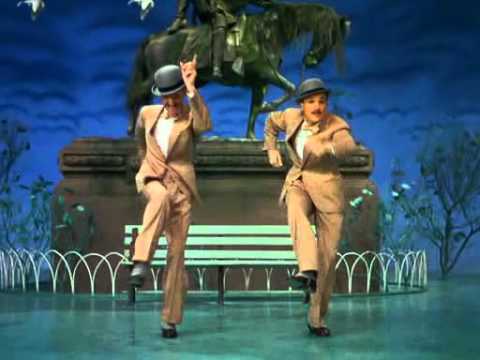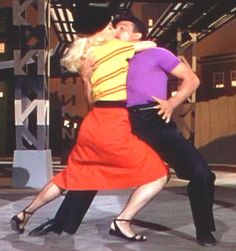Singin’ in the Rain is celebrating its 70th Anniversary this year. It is widely considered to be one of the best (if not the best) musicals of all time. I have seen this movie a million times. I’ve seen it in the theater multiple times. I own the huge box set. I love this movie. While it might be a cliche answer, considering its popularity, Singin’ in the Rain is my favorite musical. At the time the film came out however, it wasn’t thought to be anything special. It did turn a profit, but nothing remarkable. Even the origin of the film came from humble beginnings.

Arthur Freed, head of the “Freed Unit” and in charge of MGM’s musicals, wanted to develop a film based around the catalog of songs written by himself and composer Nacio Herb Brown. The only original songs written in 1952 for Singin’ in the Rain, were “Moses Supposes” and “Make ‘Em Laugh.” It is pretty clear however, that “Make ‘Em Laugh” is a rip-off of Cole Porter’s “Be a Clown.” There’s a pretty funny anecdote involving Freed showing Porter around the set during the production of Singin’ in the Rain. The cast and crew were rehearsing Donald O’Connor’s memorable “Make ‘Em Laugh” routine. Cole Porter heard the music and said “isn’t that ‘Be a Clown?'” Freed distracted Porter from the song before answering.

The most memorable song in Singin’ in the Rain is the title song, “Singin’ in the Rain,” featuring Gene Kelly’s character, Don Lockwood, doing what else? Singing in the rain. Kelly’s song and dance in the rain is iconic and one of the most indelible scenes of Classic Hollywood cinema. In the musical number, Don is overjoyed after coming up with a plan to save his movie career and falling in love with Kathy Selden, played by the adorable and hugely talented Debbie Reynolds. There are some urban legends surrounding Kelly’s performance of the big title song dance number. One urban legend is that the water is actually milk, with the idea that milk would be more visible on screen. Co-Director Stanley Donen (Kelly was the other director), debunked this myth. One story that is true however, is that Gene Kelly was suffering from a horrible fever during production of his big dance number. It’s amazing that he was able to perform it so well and effortlessly, despite being so sick.

“Singin’ in the Rain” was first heard in 1929, in the film Hollywood Revue of 1929. The song was performed by Cliff Edwards, who is best remembered now as the voice of Jiminy Cricket in Disney’s Pinocchio. Edwards is seen wearing a raincoat and hat, while warbling this song in the rain. It was a big hit in its day, but Gene Kelly definitely added some life to the song in 1952. Another song from Singin’ in the Rain that was recycled, was “Good Morning.” In the 1952 film, Debbie Reynolds, Donald O’Connor, and Gene Kelly sing the song after they realize that it’s past midnight after a disastrous film premiere. This song leads into Cosmo’s (O’Connor) brainstorm–turning Don and Lina Lamont’s (Jean Hagen) film, The Dueling Cavalier, into a musical. Judy Garland was heard singing “Good Morning” in her 1939 film with Mickey Rooney, Babes in Arms.

After it is decided to transition The Dueling Cavalier into a musical, Don and Lina are ordered to attend elocution classes. Miss Lina “And I Can Stan’ it!” Lamont definitely needs all the help she can get. Don, on the other hand, speaks fine, but is forced to go through these classes as well. We see him learning how to pronounce his “A” vowel sounds and say tongue twisters like “Chester chooses chestnuts, cheddar cheese with chewy chives. He chews them and he chooses them. He chooses them and he chews them, those chestnuts, cheddar cheese and chives in cheery charming chunks.” Cosmo shows up he and Don and end up singing “Moses Supposes” with a lot of rhymes. This number is used as a showcase for Gene Kelly and Donald O’Connor, but you cannot help but feel sorry for the poor elocution teacher. “Moses Supposes” was one of the original songs written for the film.

After dropping Don Lockwood off at a Hollywood party, Kathy Selden (Reynolds) makes her big splash in Singin’ in the Rain with her adorable performance in “All I Do is Dream of You.” Kathy and a chorus line of girls are seen in cute pink outfits while doing the Charleston amidst a storm of confetti. Don is instantly smitten with her, and so is my husband. My husband finds Debbie absolutely adorable in this number. My favorite part of “All I Do is Dream of You” is when Debbie so effortlessly removes a piece of confetti from her face. Whether that was scripted, I don’t know, but she made it look so easy. What an amazing lead role film debut for Debbie. She was so talented. “All I Do is Dream of You” can be heard as an instrumental song in the Marx Brothers’ A Night at the Opera.
After Kathy sings “All I Do is Dream of You,” she unfortunately ends up hitting Lina in the face with a pie that she intended for Don. She runs out of the party in embarrassment. Lina reciprocates by having her fired. Don looks in vain for Kathy, but doesn’t have any luck. Eventually, Cosmo ends up performing a very acrobatic rendition of “Make ‘Em Laugh” in an attempt to cheer Don up. Let’s face it, this song is “Be a Clown.” There is no mistaking that. However, for all intents and purposes, it’s “Make ‘Em Laugh” in Singin in the Rain. Donald O’Connor’s solo dance is absolutely fantastic. I don’t know any other dancer(s), except for maybe The Nicholas Brothers, who could have performed the acrobatics required of this dance number. O’Connor is amazing.

One of my absolute favorite things in a Classic Hollywood film is the random fashion show. Singin’ in the Rain does not disappoint and features a fashion show in the middle of the film during the “Beautiful Girl” montage. This section of the film is kind of random. My husband doesn’t like it because he feels like it is disjointed from the rest of the film. Me on the other hand, enjoy it because it features a fashion show and this section also serves as a way to get Don back with Kathy when we discover that Kathy is now working as a chorus girl in this musical number on an unnamed film. Singin’ in the Rain very effortlessly segues from the musical interlude to the story involving Kathy and Don. The other purpose that this section serves is that it shows how Monument Studios has had to adapt in face of the burgeoning technology of “talking pictures.” Now they’re producing musicals–a genre that wouldn’t have been possible during the silent era.
The “Beautiful Girl” montage opens with a mash-up of “I’ve Got a Feelin’ You’re Foolin,” “The Wedding of the Painted Doll,” and “Should I?” Images of flappers, women dressed as toy soldiers, and a man with a megaphone are seen. “I’ve Got a Feelin’ You’re Foolin'” debuted in 1936 in Broadway Melody of 1936. “The Wedding of the Painted Doll” was heard in another ‘Broadway Melody’ film, Broadway Melody of 1929. Finally “Should I?” was heard in Lord Byron of Broadway in 1930. The montage transitions into a man singing “Beautiful Girl” which was heard in the film Stage Mother in 1933. Kathy Selden is one of the chorus girls in the “Beautiful Girl” number. This scene then switches into an amazing fashion show–one of my favorite random fashion shows in film.

The ‘Broadway Melody’ films provided a lot of music to Singin’ in the Rain. In the big closing number, Broadway Melody is presented as the imagination of Cosmo Brown and Don Lockwood as they pitch the revamped version of The Dueling Cavalier to Monument Pictures Studio head, RF Simpson (Millard Mitchell). The big “Broadway Melody” number was featured in Broadway Melody of 1929 along with “The Wedding of the Painted Doll.” “Broadway Rhythm” was also featured in 1936, in Broadway Melody of 1936, along with “I’ve Got a Feelin’ You’re Foolin’.” I love this part of the film. Cyd Charisse as the flapper in that green, fringed dress is gorgeous. She and Gene together are sizzling hot. This is one of the sexier dance numbers during the Golden Age of Hollywood. I love the music. Charisse is seen later wearing a white version of the same dress and later, a white dress with her own hair, and an enormous, flowing white veil. This is a very dramatic number set to an original song, the “Broadway Ballet,” composed by Nacio Herb Brown. This number is fantastic and I love it.
In the Classic Hollywood era, it is easy to find costumes and songs recycled from other previous films. If you have a great costume, or a great piece of music, why not re-use it? Singin’ in the Rain is proof that you don’t have to develop an entire catalog of new songs if you have songs that will suit the purposes of the film. However, the caveat to this is that you have to have writers that are talented. Props have to be given to the writing team of Adolph Green and Betty Comden. They were given a stack of songs and told to write a story using these songs, and boy did they deliver!

LINA: I’m a shimmering, glowing star in the cinema firmament.
Jean Hagen as “Lina Lamont” in Singin in the Rain (1952)

No! No! No!
Yes! Yes! Yes!
No! No! Nooooooooooo!
















